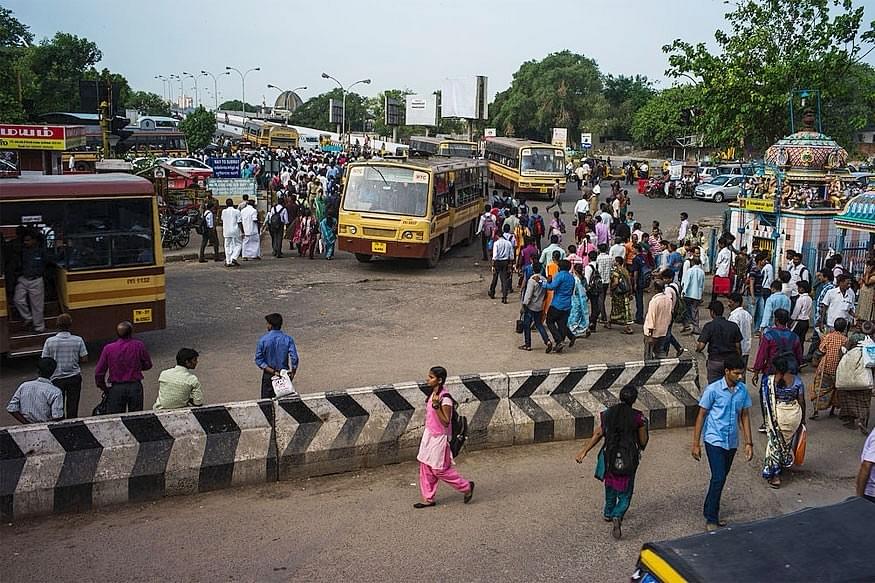Ideas
Privatisation Of Public Transport In Tamil Nadu Is Inevitable
- Why it would be better for the indebted transport corporations to have their operations privatised

Buses in Chennai (Sanjit Das/Bloomberg via Getty Images)
Several questions have cropped up after the recent transport strike that crippled the Tamil Nadu Government-owned public transport corporation’s operations for over a week.
Firstly, why can't the government-owned transport corporation be privatised? Alternatively, rationalisation in the structure and functioning of the corporations with private participation has been mooted.
Why did things descend to such levels leading to the strike? Trade unions of the State Transport Corporations (STCs) demanded a new wage settlement that has been long overdue. Several rounds of negotiations were held. Issues got complicated after the state government refused to budge with the 2.57 factor pay as demanded by the unions. This led to a flash strike until the Madras High Court intervened and found a temporary solution.
The state government, on its part, clarified that a huge pay hike is not possible as it had accumulated heavy debts to the tune of Rs 4 lakh crore. However, it has found a solution by hiking bus fares and listed several reasons in support of the hike. It has pointed at the following factors:
a) Huge salary burden with over 50 per cent of the revenue going towards salary, pension and other related items;
b) Fuel prices have increased in the last six years, since a fare hike was implemented in 2011. At least 28 per cent of a transport corporation’s revenue is spent on fuel;
c) Cost of spares and compensation paid towards loss of life and property in case of accidents have increased manifold. Over 6 per cent of the revenue is spent on maintenance;
d) The state was not rewarded by the centre in the case of fuel subsidy which adds strain in maintaining a neutral balance sheet.
Can privatisation help?
If the transport corporations are privatised, the private operators can earn steady income compared to the state. Private players too incur the same costs and face other unavoidable expenditures, including huge salary burden and social benefits. Several small fleet owners have expanded successfully within a short span compared to the state transport corporations that have around 22,000 fleets apart from 3,000 reserves at their disposal. Among these, 12,000 are under the service of urban – rural connectivity. For example, there are about 147 city private buses and 150 mofussil buses plying in Tiruchi city alone.
As reported by The New Indian Express, a government bus, on an average, collects Rs 15,000 to Rs 18,000 making eight trips, while private buses collect Rs 12,000 to Rs 18,000 making six trips. Allegations have been made against private fleet owners that they are in collusion with state transport authorities to operate the public transport fleet in a way that benefits private players.
This shows that private operators have the required ability to efficiently and profitably run a transport service. Private operators had operated buses successfully from Independence till 1971 in Tamil Nadu until the then Dravida Munnetra Kazhagam (DMK) government decided to nationalise bus transport corporations. Moreover, private buses were punctual. Therefore, handing over the sector to private players may not be a bad idea. On its part, the state government can retain the power to fix bus fares and carry out surprise checks to ensure commuters are not fleeced.
Alternatives to full-scale privatisation
Instead of handing over the operations to the private players completely, the government can rationalise the structure of the transport service. Since 1995, the state has been operating minibuses, which were run by youngsters trained in recognised driving schools. They worked on a revenue-sharing model and earned decent returns.
Chennai also has minibuses which are run by the Metropolitan Transport Corporation. This model can be expanded to regular services as well. Existing employees can get preference in the new venture of the state government. Other employees can be shifted to other government departments. The expenditure on fuel can be brought down by introducing ethanol blending and solar-powered vehicles. The government can also get relief on the tax levied on fuel, from the central government, and thereby reduce the fare. It can then hand over the rural fleet to unemployed youth who have undergone driver training.
In short, it would be better to shift the burden of running the indebted transport corporations by either partially or wholly privatising the operations.
Introducing ElectionsHQ + 50 Ground Reports Project
The 2024 elections might seem easy to guess, but there are some important questions that shouldn't be missed.
Do freebies still sway voters? Do people prioritise infrastructure when voting? How will Punjab vote?
The answers to these questions provide great insights into where we, as a country, are headed in the years to come.
Swarajya is starting a project with an aim to do 50 solid ground stories and a smart commentary service on WhatsApp, a one-of-a-kind. We'd love your support during this election season.
Click below to contribute.
Latest